I arrived just about 8:00 AM, February 8th, 2017, at the parking lot at the entrance of Dixon Lake. On weekdays there is no entry fee. I had an hour-and-a-half before I needed to head to work. Rather than visiting the lake proper, I decided to stay up in the picnic area and chaparral above the north shore of the lake.
The first birds were heard as I opened the car door, before I even got out. A dozen American Robins were there--some already apparently paired up. One of the robins had ugly swollen legs, as several did here last year--probably a scaly mite infection. Several Dark-eyed Juncos were feeding in the lawn, some House Finches were flying about, a Mourning Dove was cooing, and a couple of Yellow-rumped Warblers were working the tops of the California pepper trees that were just getting the first warming rays of sun as they lined the parking lot.
I walked through the first picnic area and down the hill slightly to the adjacent Jack's Creek picnic area. There were fewer birds this morning here, still in shade. A Nuttall's Woodpecker was working the dead top of a sycamore branch.
 |
| Nuttall's Woodpecker. |
Leaving the picnic area and crossing the road to the north leads to the trailhead for the Chaparral Trail. The mixed chaparral is heavy here. I'm still learning the plants, but laurel sumac and big clumps of chamise were mixed in with several species of evergreen oak trees. This trail follows a creek bed--usually dry, but now was running after several days of recent rains the past two weeks.
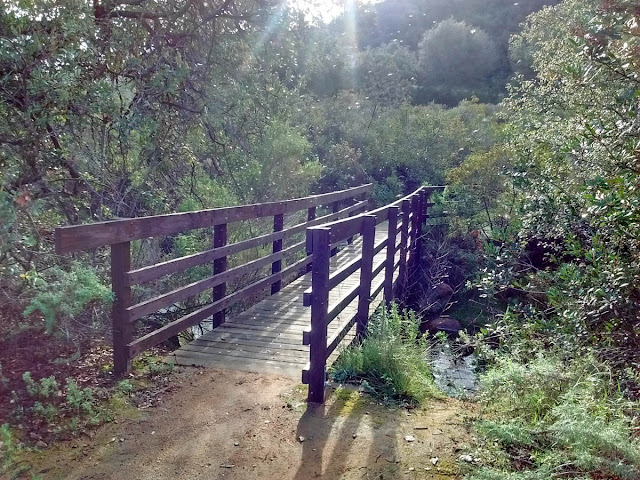 |
| There was actually water running in the creek! |
A trailside sign identified the oaks and called attention to a "coast wild lilac" but didn't give its scientific name. The three parallel veins running down the leaf identify it as a
Ceanothus, but exactly which of the 50-60 species this is I am not sure.
 |
| Wild Lilac (Ceanothus spp.) starting to bloom. |
Three species of evergreen oaks occur together here. Most of the larger oaks are coast live oaks. A sign brought attention to the more blue-gray smooth-edged leaves of the Engelmann's Oak. Some scrub oak were also present. And in the oaks,... Oak Titmouses.
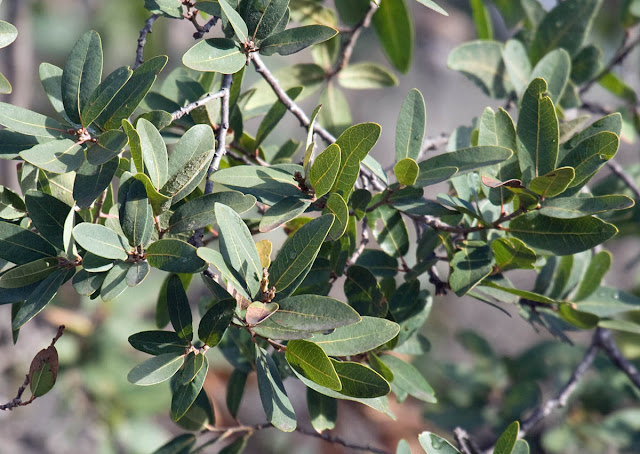 |
| Engelmann's Oak. |
 |
| Scrub Oak. |
The nature trail goes uphill for almost one-half mile. Near the top I've noted wintering Fox Sparrows in the past but had a hard time seeing them in the riparian tangles of brush and scrub oaks. The loud smacking "tchuck!" or "check!" call told me I was looking for the Sooty Fox Sparrows, or maybe one of the Slate-colored Fox Sparrows, but not the Thick-billed Fox Sparrows, which have a metallic "zink!" call. About 20 subspecies of Fox Sparrows can be divided into 4 groups (including the Eastern Red Fox Sparrows). These 4 groups are long overdue to be split into 4 separate species.
Eventually, I spotted some very pale (pale for Sooties), but evenly-colored Fox Sparrows, with dense breast markings. I obtained two completely out-of-focus and useless photos, and one fuzzy photo that I present here. This probably represents
unalaschcensis--the palest of the Sooty Fox Sparrows. It is also the form that breeds farthest north and west--in the Aleutians. Sooty Fox Sparrows have a leapfrog migration, with the northernmost breeders migrating the farthest south. The dark breeding form near Vancouver, Canada barely migrates at all.
 |
| Sooty Fox Sparrow -- probably unalaschcensis subspecies |
At the top of the nature trail the chaparral opens up into primarily Chamise (
Adenostoma fasciculatum) interspersed with a few yucca--Our Lord's Candles (
Hesperoyucca whipplei). The photo below shows the trail north into Daily Ranch from the nature trail. There is a seasonal pond mid-left in the photo below. A creek exits this pond via a culvert and splashes down the ravine to the right in this photo.
 |
| A dead yucca stalk stands as a sentinel over the chaparral. |
There haven't been any butterflies out for a couple of months. But this white butterfly with the orange tips to its wings was easy for me to look up and identify--the Pacific or Sara Orangetip (
Anthocaris sara). It was perhaps 1-1/2 inches wingtip to wingtip. It even kept its wings open for me for a great photograph!
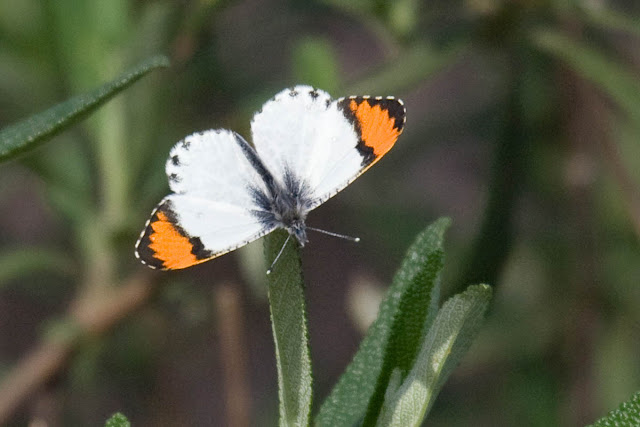 |
| Pacific Orangetip |
At this point I was running out of time, so returned directly down the nature trail again. There were a few of the red-barked Mission Manzanitas, with a few blossoms.
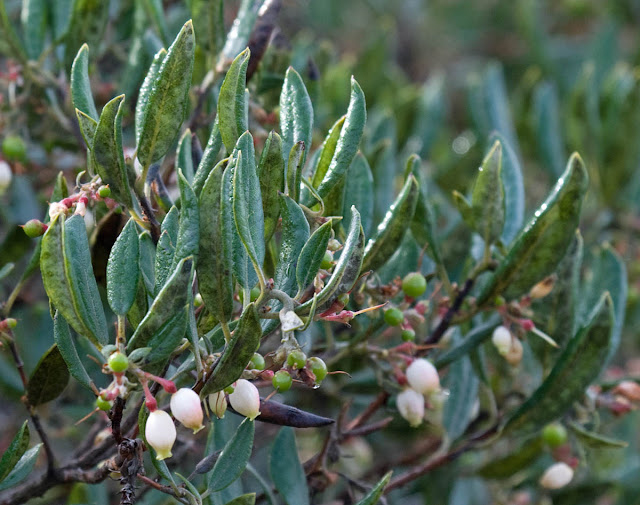 |
| Mission Manzanita starting to bloom. |
I then heard a light loose trill and spotted a singing Rufous-crowned Sparrow. After a few moments it came over to investigate me. Of the two photos below, the lower one seems to hold what I view as a more typical pose--short neck, flat head, and long rounded tail. The upper photo is more alert, which gives it an appearance similar to a giant Chipping Sparrow--which it otherwise is not shaped like.
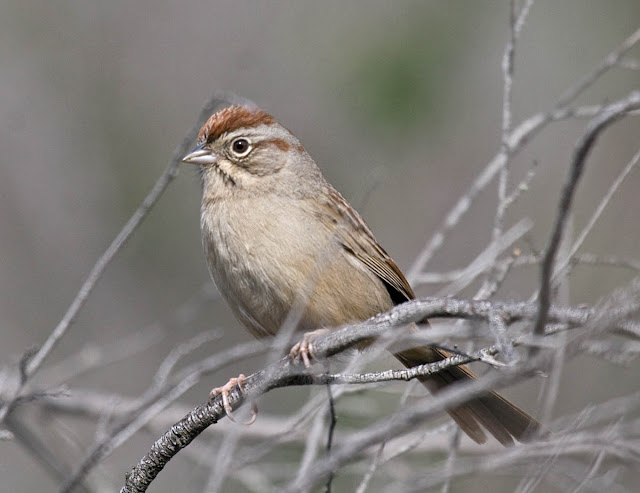 |
| Alert Rufous-crowned Sparrow. |
 |
| Rufous-crowned Sparrow, typical pose. |
In past visits I had noted a "something"--a ball of vegetable matter like a Brillo-pad. I found one again, remembered to get a photo of it, and found the source.
 |
| What is it? Wild cucumber. |
 |
| Wild cucumber. |
I believe this is
Marah macrocarpus, also known as wild cucumber, bigroot, and chilcothe. It is similar to
Marah oreganus, the old-man-in-the-ground gourd I knew in Oregon. It is less common than the similar and widespread
Marah fabaceus that has similar common names: California manroot, bigroot.
 |
| Nature Journal |
My
eBird Checklist of this hike.
eBird Hotspot for Dixon Lake.
My previous
birding site guide to Dixon Lake (written June 2016).
Mary Beth Stowe's
birding site guide to Dixon Lake (written about 2008).















While chamise does occur, I've learned that the more common plant here is California buckwheat Eriogonum fasciculatum.
ReplyDelete